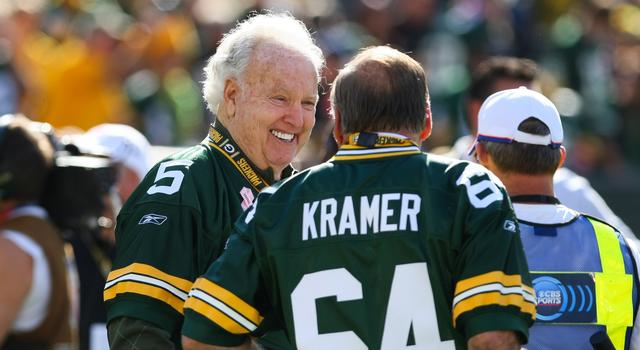

With Louisville coming in on Saturday, the 22d, Louisvillians will mark this as their first visit to South Bend for football purposes. But over 60 years ago, in a galaxy far, far away, a native son of Louisville found his way to South Bend for a little football. The kid made some history, in South Bend and at his next stop. Paul Hornung’s path to the Heisman Trophy was filled with intrigue, surprise and adventure and finished in what is arguably the most Controversial Heisman Trophy Award.
Hornung was a legenday schoolboy athlete at Flaget High School in Louisville. Jim Murray, the iconic LA sportswriter, once described Louisville, the captive of the tobacco and bourbon cartels, as “America’s Bar Rag.” Notwithstanding, Hornung eventually became a member of the High School Hall of Fame.
Frank Leahy was in his twilight when Hornung’s recruitment began. Hornung, along with Flaget High teammate Sherrill Sipes, came up on a recruiting visit for the 1952 USC game. But when the two returned home, the continued aggressive recruiting of the University of Kentucky, just down the road, accelerated. They had an aggressive young coach who wanted to “build a fence around Louiville.” He thought he could out-recruit Notre Dame and Leahy. You might have heard of the Kentucky coach, one Paul “Bear” Bryant of Moro Bottom, Arkansas. He and his staff were all over Hornung and Sipes, Yankees, and Catholic Yankees, be damned.
Hornung, with his buddy Sipes, made only one more visit to Notre Dame in the Spring of 1953. Frank Leahy was preparing for what would, horribile dictu, be his final season coaching his beloved Fighting Irish. They say in sales that a key aspect is “when I believe I am believed.” Leahy knew a bit about coaching up America’s best players. He calmly looked Hornung in the eye and told young Paul that he thought he could become the best football player in America if he came to Notre Dame.
That cinched it for Hornung, and his buddy Sherrill Sipes. The coach at Kentucky, young Bryant, was stung by the recruiting loss. He was astounded that he was outcoached, outclassed and outrecruited by Leahy. Bryant’s first loss to Notre Dame was not recorded in the coaching records, but in the recruiting ranks. Bryant would find time later, after he took the circuitous route from Lexington to College Station to Tuscaloosa, to lose the ONLY four games he ever played against Notre Dame.
Hornung was a frosh in ’53, Leahy’s last year when John Lattner won the Heisman. Then, Hornung would be coached by Terry Brennan after Leahy’s departure. Hornung was no scatback, and had all the talent that Leahy envisioned. He was 6’2″ 215 lbs. Hornung was also something that was cherished in that era: “A triple threat.” He could run, pass and KICK. As a runner, it was Hornung who would become the ballcarrier in the terrifying Packer power sweep, the pride and joy of Vince Lombardi, a guy who played for Fordham’s seven blocks of Granite under line coach Frank Leahy. Hornung ran the ball on the power sweep, while the fierce Jim Taylor was another blocker in the devastating phalanx.
Hornung was an accomplished placekicker, whose pro scoring totals were elevated by kicking 66 field goals and 190 PATS with the Packers.
Hornung was a bit of a free spirit, a playboy type whose off field escapades stood out in the sleepy hamlets of South Bend early, and Green Bay later.
But as Hornung was rising, Notre Dame was falling. Notre Dame’s hubris led it to believe that young Terry Brennan, fresh from the high school ranks in Chicago’s vaunted Catholic League could maintain Leahy’s momentum. Hogwash! Yet it is a tribute to Leahy’s sheer genius and power that he made it look easy, so easy a neophyte could do it also. That, though counterintuitive, is a mark of greatness. Frighteningly, it was an arrogant error that Notre Dame would repeat 27 years later in hiring Gerry Faust from Moeller. Brennan went 9-1 and 8-2 in his first two years, but the Leahy effect was about to wear off as the ’56 season approached.
Hornung was personable, dashing, the “Golden Boy.” He played in the era before face masks, even the primitive one bar styles, and always flashed a winning smile, even in the midst of gridiron battle. The optics were perfect for Hornung.
Hornung had finished 5th in the Heisman voting in ’55 behind winner Hopalong Cassady of Ohio State, swivel-hipped Jim Swink of TCU, Navy’s George Welch, later coach of the Middies and Virginia, and Earl Morrall of Michigan State.
Notre Dame had its best publicist ever, Charley Callahan, and he loaded his weapons for a Heisman campaign for Hornung in 1956.
Hornung did it all in ’56, completing 59 Passes for 917 yards and 3 TDs, running 94 times for 420 yards, intercepting two passes, catching three passes, averaging 15 yards per punt return and 30 yards per kickoff return, all while completing the “triple threat” by handling punting and palcekicking duties.
Hornung would finish second nationally in total offense. But the Irish struggled on the field. The only two wins were over a couple of basketball schools, Indiana and North Carolina, while the Irish finished 2-8. Michigan State’s Spartans, rising as a threat to the hegemony of the Maize and Blue, waltzed into Notre Dame Stadium and thrashed the Irish 47-14.
Of course, nothing threw Charley Callahan, the publicist, off his course, and the following week, a relatively new publicaton, challenging the role of “Sport” magazine put the photogenic, smiling Hornung on its cover. That was Sports Illustrated, then brand new. In what may have been the first recorded instance of the “Sports Illustrated Jinx,” the following Saturday Hornung and the Irish were shut out, throttled 40-0 by Oklahoma and its two Heisman candidates, will-of-the-wisp Tommy McDonald and swift hard-tackling linebacker Jerry Tubbs. In a bit of luck, Tubbs and McDonald would split the Heisman votes from the Southwest. But think about this. On successive home Saturdays, the 1956 Fighting Irish lost by a combined 87-14!
Another strong candidate for the Heisman was Johnny Majors of Tennessee, who, as a tailback in the single wing, led Tennessee’s Vols to an unbeaten regular season and the SEC championship though they did lose to Baylor in the Sugar Bowl.
Jim Brown was having a fine career at Syracuse, but do not be deceived. Brown was, in some eyes, the greatest professional football player of all time, but his dominance had not yet emerged while he was at Syracuse. And he was the fist robin of Syracuse’s running back Spring, which later included Ernie Davis, Jim Nance, Floyd Little and Larry Csonka. Syracuse was just a tad obscure in 1956, without the football pedigree of Pitt.
Hornung made his closing argument when he played halfback in the finale at the Coliseum against USC. He was forced to, as he had dislocated both thumbs. The Irish picked up their 8th loss, but Hornung in a show for the West Coast voters and press, scored all 21 of the Irish ponts.
For the season, Hornung led the team in rushing, passing, scoring, punting, total offense, field-goal kicking, kickoff return average, and minutes played, while coming in second at tackles.
Callahan was working feverishly.
Then on December 4, 1956 Hornung received a message from Callahan to come to his office. When Paul arrived, Charley handed him the phone and told Hornung to tell his mom that he had won the Heisman Trophy. Paul Hornung, the “Golden Boy” at the Golden Dome, beat Majors by only 72 votes with Tommy McDonald a strong third.
The runner up list was intriguing, with OU’s Billy Tubbs fourth, Jim Brown fifth, Ron Kramer, the prototypical tight end from Michigan, who would block for Hornung in Green Bay, sixth. John Brodie was 7th, NFL All-timer Jim Parker of Ohio State 8th, Iowa’s Ken Ploen 9th and USC’s Jaguar Jon Arnett 10th. It begs the question to compare the Heisman results with pro success, but few lists of 10 had the professional careers that this group did.
For decades, the wags at the Linebacker, Nickie’s and Corby’s would say that Charley Callahan won the 1956 Heisman Trophy, but that they merely inscribed Paul Hornung’s name on it. The Gold
But Notre Dame had its fifth Heisman Trophy winner, all coached, for at least a year, by Frank Leahy. The Golden Dome’s Golden Boy had his Golden Trophy
Go Irish!!
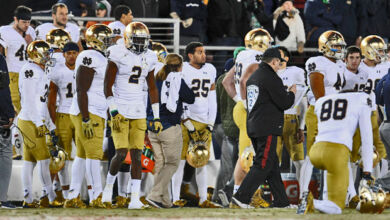
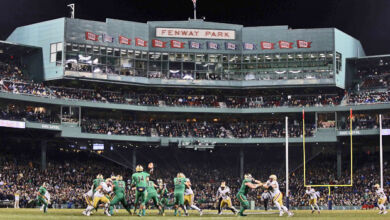
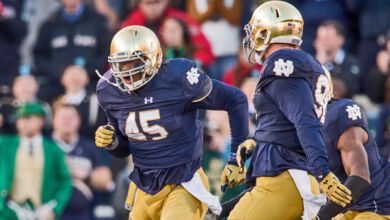
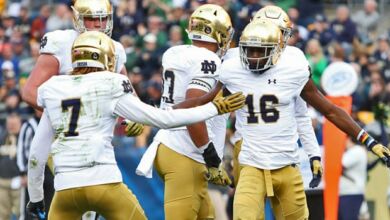
I was fortunate enough to get Hornung’s former first floor corner room at Dillon Hall some fourteen years after he graduated(Room 169). Dillon Hall has been remodeled and reconfigured since I left. That room no longer exists.
But that corner first floor window is still there.
Things were less restrictive regarding curfew hours when I attended, but I’d heard about that window
across the room from the bed as being the late entry passage way for Hornung well after curfew on many a night.
Thanks for the post, duranko.
Great off the field story on Paul Hornung the student and of you being a part of it.
southside, severl things:
The helmets were atrocious (for protectin against oncussions) back then, though linebackers were not 64″ 240 running a 4.6. And yes, thank YOU for the memory, as there was a cross on top of the helmets.
Now on to ’57. It was 7-0 but the touchdown was scored on a sweep around right end by Dick Lynch. One time on this site we had a guy who, as a kid, was selling soda in the stands that day to the Sooner faithful (47 in a
row actually) but he was an Irish fan. He stopped selling soda in the fourth quarter and just sat on a step and watched the rest of the game.
He recounted the stony silence with which the Sooner fans exited the stadium. It was one of the most elegant posts EVER on this site.
The All-Star game was last played in ’76 an was washed out in a downpour.
But agents, those scum of the earth, had as much to do as anything else with the cancellation.
Now, southside, we get ugly. Southside style! Given that you were 7 years old in ’56 you probably remember that the NFL champions that year was the New York FOOTball Giants, who lambasted Halas’ Bears 47-7 in a game not as close as the final score. Too painful to remember, eh??
Old man Halas aged 10 years on the sidelines during that whipping from the Giants. I was rooting for the Giants in’58 NFL title game. The famous Sudden Death overtime game.
I do remember those College All Star games and actually remember the All Stars almost beating the Packers when the coach finally went to John Huarte in the second half. I think Dick Lynch scored on about a 5 yard run to beat Oklahoma to break their streak. I always thought Wilkinson was more than fair to us as an announcer after we beat him. I remember specifically Wilkinson making a comment that USC got a call in their favor when we intercepted a pass in the 1969 game on prime time TV in the 21-21 tie, and interference was called. I guess interference calls from both sides of the ball are still haunting us.
Nice article and memories. I was 7 years old in ’56 and first ND game was against Indiana. The helmets back then looked like they were made out of cardboard. Correct me if wrong , but I think Irish had a cross on top of helmet. My Dad liked Brennnan because of Catholic League roots and he sent my brother and I to Mendel Catholic. In ’57 Irish did pay back on Bud Wilkerson’s Sooners ending their 40 game win streak. Final score 7-0 on an interception return. I remember those other college players Hopalong Cassidy and Jon Arnett. Does anyone remember the College All-Stars versus NFL Champs held at Soldiers Field in Chicago ? I think game was discontinued sometime in early 60’s. One more memory is of Y.A Tittle on cover of SI in ’63. He’s kneeling down on the frozen turf with blood dripping from his receding hairline. Bears beat Giants for NFL title.